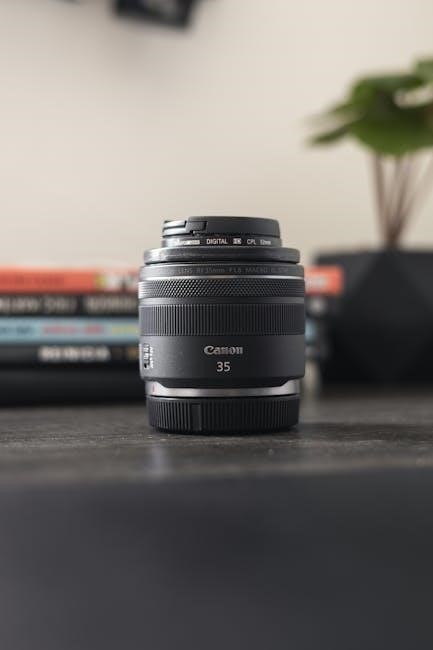Welcome to the Canon PIXMA MX922 instruction manual, your guide to understanding and maximizing the features of this versatile all-in-one printer․ This manual provides detailed setup, operation, and troubleshooting steps to ensure optimal performance for printing, scanning, and copying․ Explore wireless connectivity, ink cartridge installation, and advanced functions like photo printing and color correction․ Discover how to maintain your printer and resolve common issues for lasting reliability․
1․1․ Overview of the Canon PIXMA MX922 Printer
The Canon PIXMA MX922 is a versatile all-in-one printer designed for home and office use, offering high-quality printing, scanning, copying, and faxing capabilities․ It features wireless connectivity, allowing seamless printing from mobile devices and computers; The printer supports various paper sizes and types, including photo paper, and delivers crisp text and vibrant images․ With its compact design and user-friendly interface, the MX922 is ideal for multitasking․ The manual provides detailed guidance on setup, operation, and troubleshooting, ensuring users can fully utilize its advanced features, such as the color correction function and Canon Digital Photo Color for professional-grade photo printing․
1․2․ Key Features of the Canon MX922
The Canon MX922 impresses with its robust feature set, including wireless printing, mobile device compatibility, and high-resolution photo printing․ It supports dual paper trays, holding up to 250 sheets, and offers a 35-sheet auto document feeder for efficient scanning and copying․ The printer is compact yet powerful, with fax capabilities and a 3-inch LCD for easy navigation․ Energy-efficient and featuring auto duplex printing, it ensures cost-effective and environmentally friendly operation․ Its advanced ink system delivers vibrant colors and sharp text, making it ideal for both home and office use․ These features combine to provide a versatile and reliable printing solution․

1․3․ System Requirements for the MX922
The Canon MX922 is compatible with various operating systems, including Windows and macOS․ For smooth operation, ensure your device meets the minimum system requirements․ Windows users need versions 10, 8․1, 8, or 7, while macOS users require 10․8․5 or later․ A wireless network connection is necessary for Wi-Fi printing․ Additionally, installing the appropriate drivers and software from Canon’s official website is essential for optimal functionality․ Always verify compatibility with your operating system and network setup to ensure seamless performance and access to advanced features like mobile printing and cloud connectivity․
Installation and Setup
Begin by carefully unboxing and preparing the printer․ Connect it to a power source and follow the on-screen instructions for initial setup and calibration․ Ensure proper installation․
2․1․ Unpacking and Preparing the Printer
Start by carefully unpacking the Canon PIXMA MX922 printer from its box․ Remove all protective materials, including tapes and Styrofoam․ Ensure no accessories, such as ink cartridges or power cords, are left inside the packaging․ Gently lift the printer and place it on a flat, stable surface․ Before turning it on, inspect the printer for any visible damage or defects․ If any issues are found, contact Canon support immediately․ Remove the protective film from the control panel and ink cartridge slots to prepare the printer for setup and use․ This step ensures a smooth installation process․
2․2․ Connecting the Printer to a Power Source
Locate the power cord provided with the Canon PIXMA MX922 and insert one end into the printer’s power inlet, found on the rear of the device․ Plug the other end into a nearby electrical outlet․ Ensure the outlet is stable and not shared with other high-power devices to avoid voltage fluctuations․ Once connected, press the power button to turn on the printer․ The LED lights will illuminate, and you may hear initial startup sounds․ Verify that the power source is working by checking if the printer’s control panel lights up․ This step is essential for initializing the printer and preparing it for further setup․
2․3․ Initial Setup and Calibration
After powering on the Canon PIXMA MX922, follow the on-screen instructions on the LCD to select your language, country, and time․ Next, load paper into the rear tray as guided․ The printer will automatically align the print head for optimal performance․ Ensure the print head is properly calibrated to achieve precise print quality․ If prompted, print a test page to verify alignment․ This initial setup ensures the printer is ready for wireless or wired connections and basic operations․ Refer to the manual for detailed calibration steps and troubleshooting tips to ensure smooth functionality from the start․

Printer Setup and Configuration
Configure your Canon PIXMA MX922 for seamless operation across wireless networks, ensuring efficient printing, scanning, and copying from various devices․ Follow guided steps to install drivers and software, enabling advanced features like photo printing and color correction․ Proper setup ensures compatibility with both Windows and Mac systems, allowing you to maximize the printer’s capabilities and integrate it into your home or office workflow effortlessly;

3․1․ Setting Up the Printer on a Wireless Network
Connect your Canon PIXMA MX922 to a wireless network for seamless printing from devices․ Use the printer’s control panel or Canon Print Inkjet app to select your network name and enter the password; Ensure the printer and device are connected to the same network for optimal performance․ Download and install the latest MP Drivers from Canon’s official website to enable wireless functionality․ Verify the connection by printing a network settings page․ For troubleshooting, refer to the online manual or Canon IJ Scan Utility for detailed guidance on resolving connectivity issues and ensuring a stable wireless setup․

3․2․ Installing Print Head and Ink Cartridges
Installing the print head and ink cartridges in your Canon PIXMA MX922 is a straightforward process․ Ensure the printer is turned off before starting․ Open the top cover and unlock the print head by lifting the lever․ Remove the print head from its packaging and insert it into the printer, ensuring it clicks securely into place․ Next, install the ink cartridges by removing their protective tape and inserting them into their respective slots until they click․ Replace the print head and close the cover․ Perform a print head alignment to ensure proper printing․ Replace cartridges when low or empty for consistent print quality․
Using the Canon MX922
This section guides you through essential operations like printing, scanning, and copying․ Learn how to execute basic tasks, troubleshoot common issues, and utilize advanced features effectively for optimal performance․
4․1․ Basic Printing Operations
Learn how to perform basic printing tasks with the Canon MX922․ This section covers printing documents, photos, and more from your computer or mobile device․ Discover how to select print settings, adjust quality, and manage paper types․ Understand wireless printing capabilities and troubleshooting tips for common issues like paper jams or connectivity problems․ Find step-by-step guidance for first-time setup, including loading paper, installing cartridges, and aligning the print head․ Ensure optimal print quality by using genuine Canon ink and following maintenance routines․ This guide helps you master everyday printing operations effortlessly․
4․2․ Scanning Documents and Photos

Discover how to scan documents and photos with the Canon MX922․ This section guides you through the process of scanning to your computer or mobile device via wireless or USB․ Learn how to use the scanner glass or automatic document feeder for efficient scanning․ Understand how to adjust settings like resolution, file format, and destination folder․ Explore features like auto scan mode and OCR for converting scans to editable text․ Find tips for achieving high-quality scans and organizing your files effectively․ Troubleshoot common scanning issues and ensure your scans are clear and professional every time․
4․3․ Copying Documents
Learn how to copy documents efficiently using the Canon MX922․ This section explains how to use the printer’s document feeder for quick copying and how to adjust settings like copy quality and paper size․ Discover the option to copy double-sided documents and customize the number of copies․ Understand how to enhance text clarity and reduce or enlarge document sizes․ Find tips for maintaining the original document’s quality and organizing your copied files․ Troubleshoot common copying issues and ensure your copies are sharp and professional․ Explore additional features like multiple page copying and ensure your paper tray is correctly loaded for seamless operation․

Advanced Features and Settings
Explore advanced features like Canon Digital Photo Color for vibrant photo printing and the color correction function for precise adjustments․ Customize print settings for optimal output․
5․1․ Printing Photos Using Canon Digital Photo Color
Enhance your photo printing experience with Canon Digital Photo Color, designed to produce vivid, professional-quality images․ This feature optimizes color accuracy and detail, ensuring your memories shine․ To use it, select the photo paper type in the printer settings, choose the desired print quality, and enable color correction for precise adjustments․ The MX922 supports various paper sizes and finishes, allowing you to create stunning prints tailored to your needs․ Follow the guide in the online manual for step-by-step instructions to achieve the best results for your cherished moments․
5․2․ Using the Color Correction Function

The Canon MX922’s color correction function ensures precise control over print colors, allowing adjustments to match your creative vision․ Access this feature via the printer driver settings, where you can fine-tune color balance, saturation, and brightness․ Ideal for photographers and designers, this tool helps achieve accurate color reproduction․ Use the sRGB mode for consistent results across devices․ Refer to the online manual for detailed guidance on optimizing prints with custom color profiles and advanced settings․ This feature enhances vibrancy and ensures true-to-life tones, making it essential for professional-quality outputs․ Adjustments are easily made through the intuitive interface, ensuring your prints look their best․
Maintenance and Troubleshooting

Regularly clean the printer and print head to maintain performance․ Replace worn parts promptly to ensure quality output․ Troubleshoot common issues like print quality or paper jams by checking error messages and following manual guidelines for quick resolution․
6․1․ Cleaning the Printer and Print Head
Regular cleaning ensures optimal performance and prevents clogs․ Turn off the printer and unplug it for safety․ Use a soft, dry cloth to wipe the exterior and internal components․ For the print head, use the automated cleaning function via the printer driver․ Avoid harsh chemicals or excessive moisture․ Clean the print head no more than 3-4 times in a row to prevent ink wastage․ Refer to the manual for detailed steps․ Proper maintenance extends the printer’s lifespan and maintains print quality․ Neglecting cleaning can lead to poor output or mechanical issues, so schedule regular upkeep for reliable operation․
6․2․ Replacing Worn-Out Parts
Replace worn-out parts promptly to maintain print quality․ Start by turning off and unplugging the printer for safety․ For ink cartridges, open the print head cover and press the cartridge until it clicks, then remove and replace it with a new one․ The print head may need replacement if cleaning doesn’t resolve issues․ Use only genuine Canon parts to ensure compatibility․ After replacing, align the print head through the printer driver․ Regularly check for worn-out parts like rollers or cogs, which may require professional assistance․ Refer to the manual for specific replacement procedures․ Timely replacements prevent further damage and ensure consistent performance․

Additional Resources and Support
Access the online manual, download drivers, and explore troubleshooting guides on Canon’s official website․ Visit the support portal for FAQs, software updates, and customer service assistance․
7․1․ Accessing the Online Manual
Access the Canon PIXMA MX922 online manual directly from Canon’s official website․ Navigate to the support section, select your printer model, and download the PDF manual for free․ This comprehensive guide covers all features, setup instructions, and troubleshooting tips․ Additionally, you can find quick start guides, driver installation instructions, and warranty information․ The online manual is regularly updated to ensure accuracy and relevance․ Use the search function within the manual to quickly locate specific topics or procedures․ For convenience, the manual is available in multiple languages and formats, ensuring easy accessibility for all users․
7․2․ Downloading Drivers and Software
To ensure optimal performance, download the latest drivers and software for your Canon MX922 from the official Canon support website․ Visit the Canon website, navigate to the support section, and select your printer model․ Choose your operating system to access compatible drivers, including MP Drivers for printing and scanning functionality․ Additionally, download the IJ Scan Utility for advanced scanning features and the Quick Menu guide for easy access to printer settings․ Regularly updating your drivers ensures compatibility and enhances printer performance․ Follow the on-screen instructions to complete the download and installation process for a seamless experience․
- Visit the Canon support website․
- Select your operating system․
- Download and install the latest drivers․
- Update software regularly for optimal performance․




































